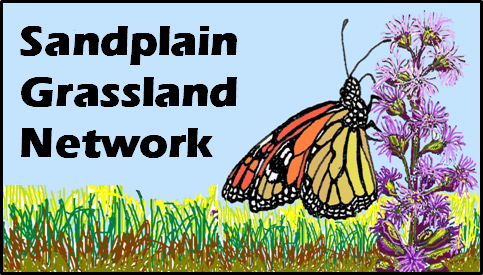Sandplain grasslands of the northeastern U.S. are iconic hotspots for biodiversity and important conservation priorities because of their relative rarity, limited geographical range, and the diversity of uncommon plant and animal species that they support. Sandplain grasslands reach their greatest extent on dry, sandy soils on coastal outwash deposits, which formed following the retreat of the southernmost extension of the Wisconsin ice sheets from Long Island to Cape Cod, including the Massachusetts islands of Martha’s Vineyard and Nantucket (Fig. 1). Additional but generally smaller areas of grasslands that have vegetation similar to that on the coastal outwash plain occur in pockets of level, sandy soils farther inland in Rhode Island, southern New Hampshire, Albany, New York, the Connecticut River Valley and on some hillier and rocker soils near the coast in southeastern Massachusetts.

Figure 1. Map of the Atlantic Coastal Pine Barrens Region in which most sandplain grasslands occur, and the Northeastern Coastal Zone within which isolated pockets of sandplain grasslands also occur. Red dots indicate sites from which management experiences and case histories were drawn in this document.
Many widely-distributed plant species adapted to droughty, nutrient-poor soils attain their greatest abundance on open lands of the coastal sandplain. Examples of these species include little bluestem (Schizachyrium scoparium), Pennsylvania sedge (Carex pensylvanica), red fescue (Festuca rubra), poverty grass (Danthonia spicata), wild indigo (Baptisa tinctorum), stiff aster (Ionactis linariifolia), and bearberry (Arctostaphylos uva-ursi), intermixed with widespread shrubs such as black huckleberry (Gaylussacia baccata), lowbush blueberry (Vaccinium angustifolium) and small bayberry (Morella caroliniensis). Sandplain grasslands contain more than 20 plant species that are listed as endangered, threatened, of special concern, or exist on state watch lists because they may become threatened. These include sandplain gerardia (Agalinis acuta), Nantucket shadbush (Amalanchier nantucketensis), sandplain blue-eyed grass (Sisyrinchium fuscatum), eastern silvery aster (Symphyotrichum concolor), purple needlegrass (Aristida purpurascens), purple milkweed (Asclepias purpurascens), and butterfly weed (Asclepias tuberosa). Sandplain grasslands support regionally uncommon grassland birds such as grasshopper sparrows (Ammodramus savannarum), savanna sparrows (Passerculus sandwichensis), eastern meadowlarks (Sturnella magna), American kestrels (Falco sparverius), northern harriers (Circus hudsonius), short-eared owls (Asio flammeus) and barn owls (Tyto alba). All of these species are uncommon or declining in the northeast. Sandplain grasslands also support a variety of moth and butterfly species such as the chain dot geometer (Cingilla catenaria), tiger moths (Grammia oithona, G. phyllira) and the frosted elfin (Callophrys irus).
Most sandplain grasslands owe their origin to land clearing and grazing that occurred in the northeast U.S. following European colonization. Smaller areas of land very near the coast probably formed a mosaic of shrubby or grassy vegetation patches, maintained in different stages of succession by the disturbances of wind, salt spray, and fires set by indigenous people, whose populations reached their greatest numbers near the coast. Grasslands expanded greatly during the expansion of agriculture and particularly animal grazing that followed European post-settlement and reached their greatest extent in the mid-1800s (Foster 2017). Frequent wildfires occurred during a period of abandonment of agriculture and subsequent forest regrowth, lasting until roughly the time of World War II, when the residential development for vacation homes began to increase (Foster and Motzkin 1999b). These fires helped prolong the existence of grasslands and associated disturbance-dependent shrublands.
While never the dominant coastal vegetation before European colonization, sandplain grasslands and interspersed shrublands were important reservoirs of the region’s biodiversity. Grasslands reached their greatest extent on Cape Cod, and on the islands of Martha’s Vineyard, Nantucket, and Long Island. Today, the area covered by grasslands is declining sharply as a result of residential development, fire suppression, abandonment of agriculture and widespread regrowth of woody vegetation. More than 90% of the coastal grasslands and related heathlands that were widespread in the northeastern U.S during the mid-19th century have been lost and this ecosystem now ranks among the northeast U.S.’s most imperiled.
